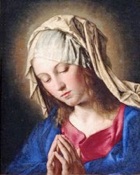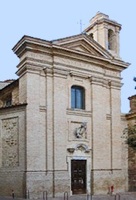
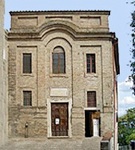
San Severo Cappella della Madonna
According to tradition, this was once the site of a temple to the sun god. A group of Camaldolesian monks founded a hermitage here in 1007 during the lifetime of St Romuald, the founder of what became the Camaldolesian Congregation of the Benedictine Order. A monastery here and its church of San Severo (which was dedicated to St Severus, Bishop of Ravenna) were confirmed as possessions of San Apollinare in Classe, Ravenna in 1037 (by the Emperor Conrad II), in 1210 (by the Emperor Otto IV) and in 1229 (by Pope Gregory IX).
By 1263, possession had passed to the Camaldolesians of San Giovanni Evangelista, Borgo Sansepolcro, an arrangement that persisted until at least the late 14th century.
In 1447, Pope Eugene IV united San Severo with the Camaldolesian monastery of SS Trinità, outside Porta San Girolamo.
Work on a new church of San Severo began in the late 15th century and Bishop Dionisio Vannucci consecrated it in 1484. The monks of SS Trinità moved here soon after, leaving their original church and monastery to dereliction.
San Severo was almost completely rebuilt in 1748-51 at the instigation of Abbot Aurelio Guidotti, using material from the derelict monastery of SS Trinità. However, because of an outcry about the potential destruction of a precious fresco (1505-21) by Raphael and Perugino (see below) in the Cappella della Madonna, the back wall of this chapel was preserved. The entrance of the room that now incorporates it is at right angles to the facade of the church. It is open to visitors.
The monastery of San Severo was closed in 1935. The church has recently reopened for services the Ordine Equestre del Santo Sepolcro di Gerusalemme (Knights of the Order of the Holy Sepulcher of Jerusalem).
Cappella della Madonna
Trinity with saints (ca. 1505-24)
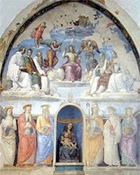
Upper Part (ca. 1505)
According to an inscription to the left of this fresco, Raphael painted the upper part of the fresco in 1505, in the time of the Prior Ottaviano di Stefano da Volterra. Some authorities query this early date, given the mature style of the fresco, but others see no reason to dispute it. This was the only fresco commission that Raphael ever won in Perugia, and it is the only certain work of his that is left in the city. It was incomplete when he left for Rome, but the monks did not give up hope of further progress until he died there in 1520.
This upper part of the fresco depicts the Trinity (although the figure of God the Father is ruined) and angels, with six saints that are identified by inscriptions:
-
✴SS Maurus, Placidus and Benedict on the left; and
-
✴SS Romuald, Benedict Martyr and John the Monk on the right.
(The last two were Camaldolesian monks from Benevento who were martyred in Poland in 1005 and whose cult was confirmed in 1508).
Lower Part (1521)
After the death of Raphael, the monks turned to the aged Perugino to complete the work. The inscription to the right records that he executed the saints to the sides of the niche in 1521, in the time of the Prior Silvestro di Stefano da Volterra. Again, these saints are identified by inscription:
-
✴SS Scholastica, Jerome and John the Evangelist on the left; and
-
✴SS Gregory the Great, Boniface and Martha on the right.
(St Boniface was a Camaldolesian monk and relative of the Emperor Otto III who was martyred in Poland in 1009).
Art in San Severo
Madonna and Child with Saints (1632)
This panel [, which is dated by inscription,] is by Stefano Amadei.
Christ in Glory (18th century)
This panel is by Francesco Appiani.
Art from San Severo
Tabernacle (late 13th century)
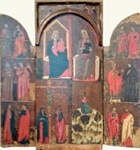
-
✴The central panel contains four scenes:
-
•St Anne and the baby Mary enthroned;
-
•the Madonna and Child;
-
•the Crucifixion with the Virgin and St John the Evangelist; and
-
•Christ’s agony in the Garden of Gethsemane.
-
✴Each of the side panels has pairs of saints in three registers:
-
•SS Peter and Paul; a monk and an angel; and SS Catherine of Alexandria and Cecilia on the left; and
-
•SS John the Baptist and Laurence; SS Augustine and the Blessed Sperandius (identified by inscriptions); and St James and another Apostle on the right.
Two angels above the central panel can still be seen when the doors of the tabernacle are closed.
Crucifixion (early 16th century)
This fresco, which was detached from the wall of the Prior’s apartment in the abbey in 1863, is attributed to Giannicola di Paolo. It is now in the deposit of the Galleria Nazionale.
Virgin in Prayer (ca. 1660)
